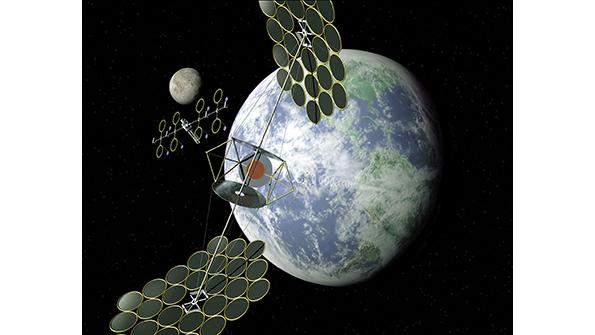Opinion: Decision Time for Space-Based Solar Power

Among the payloads aboard the sixth mission of the U.S. Air Force’s X-37B experimental spaceplane launched in May of this year was an experimental solar-power module from the Naval Research Laboratory (NRL). It demonstrated power generation and conversion to radio-frequency energy that could be transmitted across long distances. This is the latest development in a long history of efforts to realize the potential of large-scale collection of solar power in space and delivery of that power to distant users. If successfully demonstrated, solar-power satellite (SPS) systems could have dramatic implications for all sectors of space activity and eventually for terrestrial users as well.
U.S. research organizations and government agencies have studied SPS concepts for more than half a century. But the concepts have yet to reach fruition because the technology and economics are challenging, and U.S. efforts have been minimally funded. Aside from sporadic activity like the NRL test, little is being done in the U.S. to initiate a series of flight experiments that would lead to demonstration of a complete system.
Several nations appear to be accelerating their efforts in this area. Japan has been keenly interested in SPS for a long time, and China, Russia, India, South Korea and other countries are increasingly active. Geopolitically, the race to become a leader in space-based solar power could be a key component in a competition to dominate cislunar space. Alternatively, leading SPS innovators could work together to address global energy security and greenhouse gas emission challenges.
Early studies, including one by NASA and the Energy Department in the late 1970s, focused on serving the terrestrial power grid. This remains an important objective as demand for electricity continues to grow worldwide, but serving niche markets on Earth and in space may become technically and economically feasible much sooner. Some experts believe SPS can become a competitive contributor to the grid, although it may take a few decades.
In the meantime, some terrestrial energy users have special needs that incur very high costs. Nowhere is the cost of electricity higher than on forward-deployed military bases—because it is measured in human lives and combat effectiveness as well as dollars. Where bases are powered by generators that require transporting liquid fuels through hostile territory, fuel convoys frequently have been subject to attacks. Estimates for the cost of fuel deliveries in Operation Iraqi Freedom in the mid-2000s ranged from $15 to hundreds of dollars per gallon. And those estimates did not include the cost of casualties.
Many nonmilitary electricity users also could benefit from SPS. Isolated communities could end dependence on generators. On-demand power from orbit could replace or augment intermittent ground-based renewables. Large power users could reduce or eliminate their dependence on the grid or dedicated power-generation capabilities by leasing satellite beams. Such power-hungry users might include industrial facilities, electric rail systems serving regional or national routes, electric-vehicle charging stations, computer server clusters and desalination plants.
The first customers of beamed power could be satellites and facilities in cislunar space. For example, wireless power transmission could serve lunar mining, including the harvesting of ice deposits at the lunar south pole. The energy-intensive work of extraction and processing could be powered by SPS systems in lunar polar orbit. Alternatively, the sun-drenched peaks above near-polar craters could host solar collectors that beam power into the permanent darkness below.
Collection of solar power in space and power transmission across distances are both demonstrated technologies. However, many challenges still need to be overcome to achieve technical and economic feasibility. At the top of the list is the launch cost for massive SPS systems.
Technological advancement and new SPS design proposals are addressing these challenges. Early research focused on design concepts involving large assemblies; the 1990s saw a move toward partially modular structures. More recently, the focus has been on completely modular structures that reduce costs and increase flexibility. Developments inside and outside the space industry include more affordable launch opportunities, advances in solar cell efficiency, mass production of modular components, the potential for robotic assembly and the feasibility of funding multibillion-dollar commercial space projects.
In addition to small-scale tests such as the NRL’s recent on-orbit power module experiment, many other space- and ground-based elements must be tested in realistic operational environments. A coordinated and sustained program leading to a large-scale demonstration of a complete system is a logical path for decision-makers to consider. Several countries are now making this investment, and U.S. decision-makers should seize the opportunity during the next presidential term to reenergize U.S. leadership in this potentially disruptive technology. If SPS development succeeds, the economic and environmental implications could be enormous. The U.S. will want to be at the forefront of high-capacity power-beaming in all its applications rather than become dependent on others for the technology and the capabilities it provides.
James Vedda and Karen Jones are senior policy analysts at The Aerospace Corp.’s Center for Space Policy & Strategy. This article is adapted from their chapter in Space Agenda 2021.
The views expressed are not necessarily shared by Aviation Week.




Comments